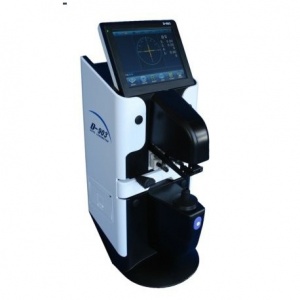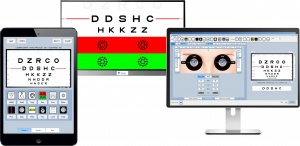We rely on our sight in all aspects of daily life and therefore an eye examination is essential to monitor eye health and maintain for clear, comfortable vision.
We strive to provide the most thorough eye examinations using the latest technology and equipment so you, the patient, have full confidence in our findings and recommended management.
There are hundreds of different ways to do the tests in your eye examination. This guide shows a typical example of each. You may not have all the tests described, because your optometrist will tailor your eye examination to suit your individual needs.
1. Visiting The Opticians
Helen and Jo make sure that your confidential customer record is accurate and up-to-date. If you are wearing contact lenses, you need to remove them before your eyes are tested.
Picture of the team

2. Using a Non-Contact Tonometer
Using a non-contact tonometer the Optometrist, Ellie or Atiq, blow a few puffs of air at each of your eyes in turn. The air bounces back at the instrument, giving a measurement of the pressure inside each eye.
This is an important test, as high pressure can indicate the early stages of glaucoma, a sight-threatening condition.
3. The Focimeter
If we do not have a record of your current prescription, the focimeter can read it from your glasses so that it can be compared with the findings of your eye examination by the Optometrist.
4. About Your Health and Lifestyle
The optometrist asks questions about your health, your family’s health, your work and your lifestyle. It is very important to have a clear understanding of your vision needs, especially if a specific problem is the reason for your visit.
Picture of the team
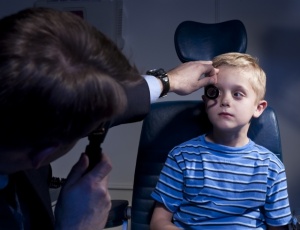 5. The Retinoscope
5. The Retinoscope
The Optometrist, Elvira and Atiq, may use an instrument called a retinoscope, which bounces a light beam off the back of your eye and back into the instrument. Different lenses focus the reflected light beam until it is steady, giving a close guide to the prescription you need. The retinoscope is very accurate – it is used to test the sight of very small children, or people with communication difficulties who can’t easily describe how clearly they can see.
6. The Test Chart
At Hanson Opticians we use a modern computerised test chart to allow us to randomise the letters. The Optometrist fine-tunes the findings by asking you to read the test chart through different strength lenses. The results for one eye often vary from those for the other, so each eye will be tested individually before both eyes are finally tested together.
The Optometrist flips different lenses in front of your eyes that change how clearly you can see. Depending on your answers, the Optometrist changes the lenses until you have the clearest, most comfortable vision possible.
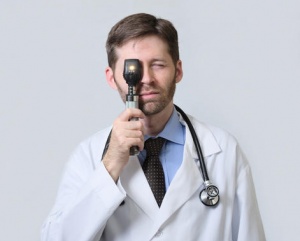
7. Using The Ophthalmoscope Or The Slit Lamp
The Optician uses an ophthalmoscope or Volk lens to examine the retina at the back of the eye, including the blood vessels and the front of the optic nerve. This important test can detect changes which can indicate diseases such as diabetes or high blood pressure. The Optician darkens the room and sits quite close to you depending on the procedure, while they shine a bright light into each eye in turn using the ophthalmoscope or volk lens. The light may leave shadows on your vision, but these soon fade.
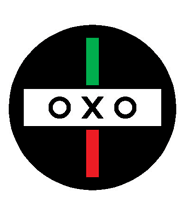
8. The Oxo Box
You are also asked to focus on an oxo box, and say whether the illuminated lines are in line horizontally and vertically.
This indicates whether your eyes work well together – balanced and co-ordinated eyes are essential for clear comfortable vision.
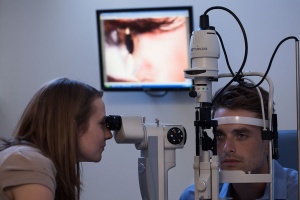
9. The Slit Lamp
The slit lamp is a powerful, illuminated microscope that is used to examine the outer surface of your eyes – the cornea, the iris and the lens – to check for abnormalities or scratches.
This is a very important test for contact lens wearers.

10. Visual Field Screener
A visual field screener randomly flashes dots of light on a black background.
If you fail to see any of the dots, this can be an indication of a blind spot.

11. Testing Your Focus
The Optician may test your ability to focus at varying distances to decide if you need different prescriptions for distance and reading.

12. Discussing Your Needs
The Optician will try to answer your queries during the eye examination, and will explain the findings.
If the Optician considers that you would have clearer vision with a change of prescription or new glasses, they will explain why and recommend the best options for your needs.
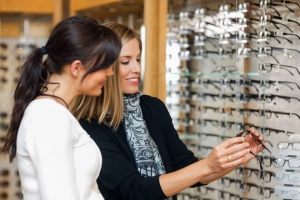
13. Choosing Your Glasses
After your eye examination, your Optician will pass on his findings and recommendations to a dispenser, Helen or Jo, who will help you to choose your new glasses.
Change
background
colour:

